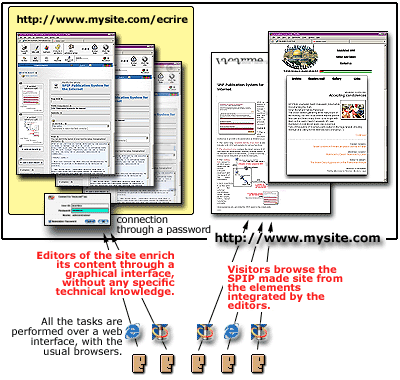SPIP, a publishing system
SPIP is a publishing system for the Internet.
Come again? It consists of a collection of files installed on a web server which allow you to take advantage of a number of automated tasks: multi-user management, laying out your articles without the need to use HTML, easily modifying the structure of your site, etc. Using the very same computer application that you would normally use to browse a site (Chrome, Firefox, Edge, Safari, Opera...), SPIP enables you to build and update your site thanks to a very simple user interface.

There are many other content management systems available, and each one has its own characteristics and particularities. SPIP is mainly orientated towards the creation of a magazine structured site: i.e. with sections, sub-sections (and so on), where you can insert articles and news items which can then be supplemented with discussion forums.
Why SPIP?
SPIP is a free software distributed under the General Public License (GPL). SPIP’s requirements in terms of software and hardware are very modest indeed and they are even provided by some free hosting ISPs (see the FAQ and the installation guide for more details – or to be extremely brief: PHP+MySQL).
SPIP is freely distributed on this site at: Downloading SPIP.
SPIP has some significant advantages:
- you can manage a magazine type site, i.e. one made up chiefly of articles and news items, inserted in a hierarchy of sections that are nested one within another. See the complete list of SPIP’s features for more details.
- it completely separates and distributes three kinds of tasks amongst the site’s various contributors: the graphic design; the site editorial input through the submission of articles and news items; and the site editorial management (which includes organising sections, validating article submissions, etc.).
- the webmaster and all of the site contributors are relieved from a number of tedious aspects of web publishing, as well as eliminating the need to spend a long time learning special technical skills. The installation of SPIP is performed step by step through a simple interface and, when completed, allows you to start creating your own sections and articles straight away.
SPIP has the following features:
For the editor(s) and administrator(s)
- An intuitive web interface greatly facilitates article and news item composition and submission as well as the editorial management of the site. Furthermore, a number of typographical shortcuts allow the text to be reformatted without needing to use HTML tags, which makes editing tasks accessible to everyone, just as easy as composing an e-mail message.
For the webmaster
- The graphical side and the navigation in the site are defined by HTML layout templates (or "master pages") each of which defines a "view" (for instance: a view of the index page, another showing a section and a brief summary of its contents, a third one for the details of an article, a fourth for the details of a news item). Editorial content is inserted into those pages by using a number of HTML-like pseudo-tags which are relatively straightforward to learn and understand.
- SPIP does not restrict your use of graphical and navigational choices of your site. The HTML templates are entirely customisable by the webmaster. It is possible to control a parts of the site with SPIP, with the rest being created manually or even with other publishing systems (providing these systems are just as tolerant as SPIP, of course).
For site visitors
- A cache system in the public area of the site speeds up browsing by avoiding an excessive number of repetitive database queries, and which safeguards against that database crashing (which can be quite frequent on "overloaded" servers): in such cases where the underlying database is temporarily unavailable, the site remains transparently and continuously available, even if users can’t make any new content contributions or modifications (including posts to a forum).
- A search and indexing engine integrated into SPIP, which, if enabled by the webmaster, enables search functionality over the entire content of the public site.
Examples
The best (and historically first) example of the use of SPIP is the e-zine uZine2 (it was initially the specific code of this site which was used to create the original SPIP). Amongst other sites running under SPIP, we would like to mention Le Monde Diplomatique in English and Vacarme.
And what else?
In order to get deeper into SPIP, we recommend that you carefully read the online documentation, the examples and the "first steps" offered in this section. Mailing lists are also available for posting questions and offering helpful tips.
And if you’re really keen, there’s also the SPIP Programmer’s Guide